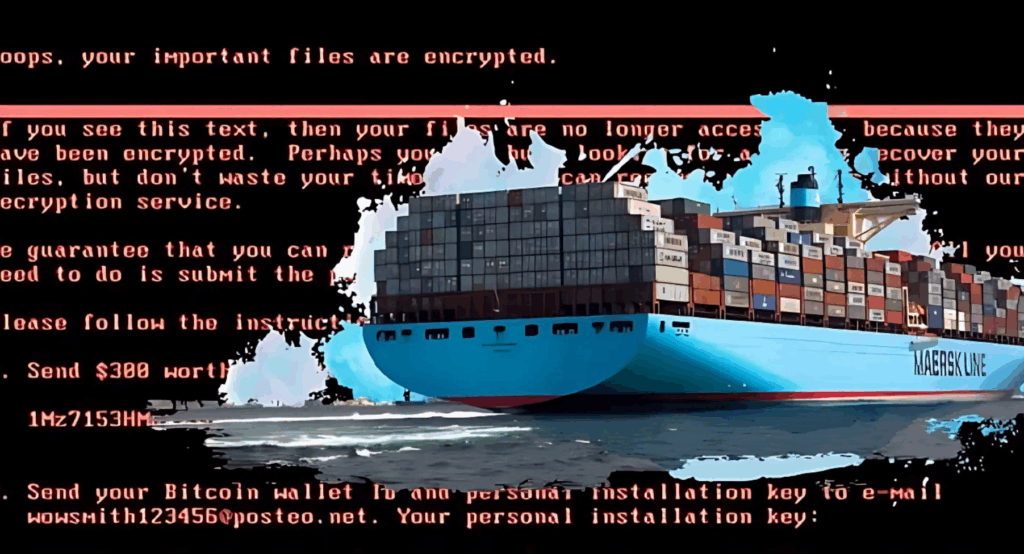Case Study
Operational Meltdown from Cyber-Attack – Maersk (2017)
6 Strategic Lessons in Cyber Resilience for IT Leaders
What Happened: The NotPetya Cyber-Attack that Brought Maersk to Its Knees
In June 2017, global shipping and logistics giant Maersk fell victim to the NotPetya malware, a sophisticated cyberattack believed to be state-sponsored. The malware, disguised as ransomware, spread rapidly across Maersk’s global IT infrastructure—crippling terminal operations, container tracking systems, and internal communications.
The company lost access to 49,000 laptops and over 1,000 applications. Multiple ports around the world were paralyzed, causing a complete breakdown in cargo handling operations.
Maersk was not directly targeted but was collateral damage, as the malware spread via Ukrainian accounting software. However, its global network architecture enabled the malware to replicate with stunning speed and scale.

Financial and Operational Impact
The consequences were staggering:
- Estimated loss: US$300 million in missed revenues, port shutdowns, and recovery costs
- Operational delays: Ships were rerouted or delayed for days, affecting global supply chains
- Customer disruption: Thousands of cargo shipments were affected, leading to contractual penalties
Yet, despite the devastation, Maersk’s swift and methodical response became a model in post-breach leadership.
Strategic Response from Leadership
Recognizing the scale of the crisis, Maersk formed a cross-functional Data Risk & Governance Office that tackled the problem with a holistic view:
- End-to-End Data Lineage Mapping: Understanding how data moved through systems to evaluate vulnerability paths
- “Data Blast Radius” Analysis: Identifying how far and deep malware could potentially spread within their architecture
- Global Backup and Recovery Strategy: Rebuilding IT infrastructure with strong segmentation and redundancy
- Crisis Management Playbooks: Formalizing incident response procedures for future attacks
Implementation Timeline
- Within 48 hours: Activation of emergency crisis response teams
- By Month 3: Infrastructure rebuilding in 150 sites across 100 countries
- By Month 18: A complete data governance framework and disaster recovery model was operational, focusing on business continuity and resiliency
Competitive Advantage Achieved
Post-recovery, Maersk turned its new capabilities into a selling point:
- Business Continuity Guarantees became part of enterprise customer SLAs
- Cyber-Resilience Certification was integrated into client RFPs and global marketing
- Trust Rebuilt: The transparent, proactive response reinforced Maersk’s leadership in supply chain risk management
What IT Leaders Must Learn: 6 Critical Resilience and Governance Strategies
1. Map End-to-End Data Lineage Across Systems
What Went Wrong:
Maersk’s flat, unsegmented network allowed NotPetya to spread rapidly across countries and departments.
Best Practices for IT Leaders:
- Data Lineage Tools: Use automated platforms to map data flow across systems and applications.
- Dependency Mapping: Identify which systems rely on which data flows to prioritize defenses.
- Access Path Reviews: Regularly audit how data is accessed and by whom to tighten controls.

2. Assess and Contain the "Data Blast Radius"
What Went Wrong:
Lack of micro-segmentation allowed a single entry point to impact multiple business units globally.
Best Practices for IT Leaders:
- Network Segmentation: Divide infrastructure into isolated zones with strict access rules.
- Attack Simulation: Run penetration tests and red-teaming to understand how far malware could realistically spread.
- Blast Radius Modeling: Simulate how attacks impact data availability, regulatory exposure, and customer impact.
3. Build a Global Data Backup and Rapid Recovery Strategy
What Went Wrong:
Best Practices for IT Leaders:
- Immutable Backups: Store encrypted, write-once backups off-network or in the cloud.
- Geographic Redundancy: Back up critical systems across multiple continents.
- Recovery Playbooks: Design and regularly test RTO (Recovery Time Objective) and RPO (Recovery Point Objective) plans for key services.

image source- grahamcluley
4. Establish a Dedicated Data Risk & Governance Office
What Went Wrong:
Best Practices for IT Leaders:
- Cross-Functional Team: Include legal, security, IT, business ops, and compliance in the governance structure.
- Policy Alignment: Harmonize backup, access control, and retention policies across business units.
- Risk Reporting Framework: Develop dashboards for real-time threat awareness and compliance alerts.
5. Embed Cyber Resilience in Contracts and SLAs
What Went Wrong:
Best Practices for IT Leaders:
- Continuity Clauses: Include cyber-resilience promises in customer-facing contracts.
- Third-Party Compliance: Hold vendors to similar business continuity standards.
- Certifications: Obtain ISO 27001, SOC 2, or NIST-based audits to signal credibility.
6. Conduct Regular Crisis Simulations and Executive Drills
What Went Wrong:
Best Practices for IT Leaders:
- Executive Tabletop Exercises: Simulate ransomware, DDoS, or insider threats with senior leadership.
- Cyber War Rooms: Set up virtual environments for live-response training.
- Post-Mortem Culture: After every drill or real event, perform transparent reviews and share learnings across departments.
Conclusion: Turning Crisis Into Capability
The 2017 NotPetya cyberattack on Maersk was one of the most operationally disruptive cyber incidents in history. But it also became a defining moment for the company’s leadership—transforming a $300 million loss into a competitive edge.
For IT leaders, Maersk’s experience highlights the value of:
- Preparedness over reactivity
- Segmentation over scale
- Cross-functional collaboration over siloed execution
Cyberattacks are inevitable. But with the right governance, resilience, and recovery strategy, enterprises can emerge stronger, smarter, and more secure than before.

image source- rappler

Let YALLO Solve Your Talent Challenges
Struggling with complex IT needs? Partner with YALLO for tailored solutions that reduce costs, improve quality, and deliver results. Book an appointment today to discuss how we can help your business thrive.














